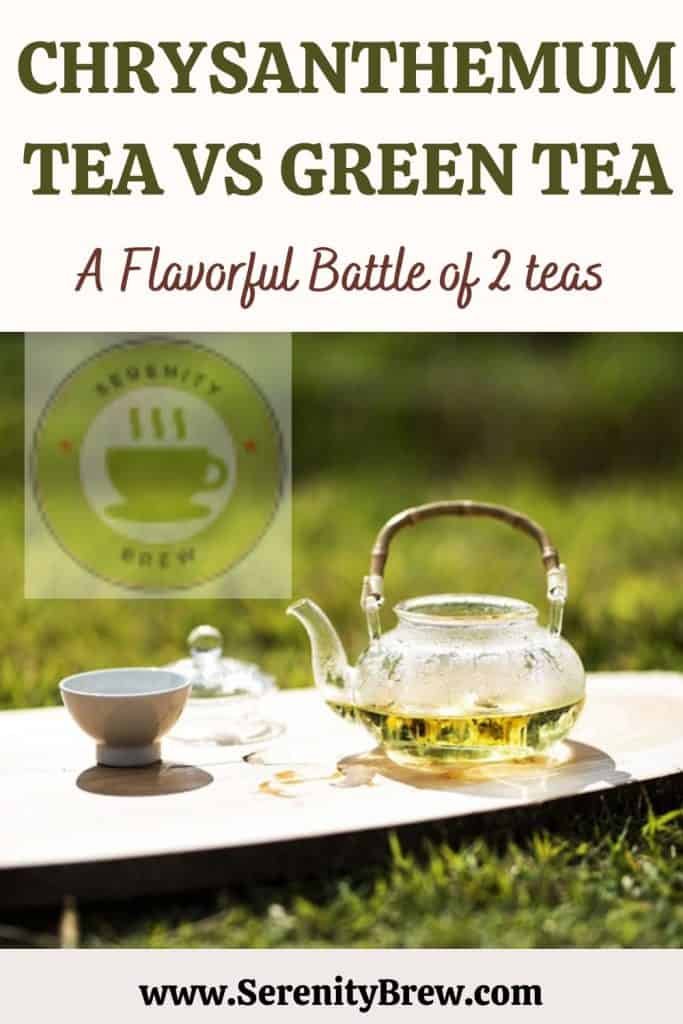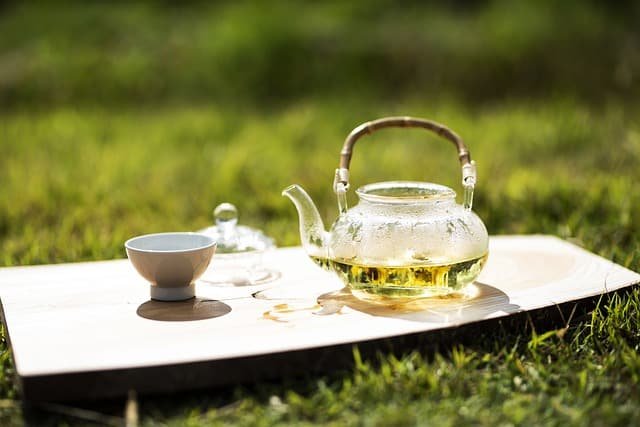
Chrysanthemum tea and green tea are both popular beverages with a variety of health benefits. While green tea has gained significant attention worldwide, chrysanthemum tea also holds its own with its unique characteristics and advantages. In this article, we’ll be exploring the differences and similarities between these two refreshing tea options.
Chrysanthemum tea is a floral infusion made from dried chrysanthemum flowers and has been used traditionally in Chinese medicine to treat various conditions . On the other hand, green tea is derived from the leaves of the Camellia sinensis plant and is widely known for its antioxidant properties and potential health benefits. The choice between these two teas will ultimately depend on individual preferences and health goals.
Understanding Chrysanthemum Tea
Origins and Background
Chrysanthemum tea, a popular herbal infusion, is made from dried chrysanthemum flowers. It has been enjoyed for its taste and health benefits for centuries, particularly in China and other parts of East Asia. The chrysanthemum flower, originating in China, holds significant cultural and symbolic importance.
Health Benefits
Chrysanthemum tea has been used traditionally to address a variety of health concerns. Some of the key benefits include:
- Antioxidant properties – The tea contains antioxidants that fight free radicals and promote overall health.
- Anti-inflammatory effects – It is believed to help reduce inflammation and alleviate associated discomfort.
- Calming properties – Chrysanthemum tea may help soothe the nervous system, potentially easing anxiety and stress.
- Eye health – In traditional Chinese medicine, it is often used to treat eye pain, and some studies suggest that it may improve vision and prevent age-related macular degeneration.
- Immune support – The tea is thought to strengthen the immune system and help fight off infections.
While the health benefits of chrysanthemum tea are promising, it is important to remember that more research is needed to understand their full extent and confirm these effects scientifically.
Understanding Green Tea
Green tea, a popular beverage known for its numerous health benefits, is made from the leaves of the Camellia sinensis plant. It is believed to have originated in China and has since spread to various parts of the world.
Types and Origins
There are several types of green tea, depending on how the leaves are processed or where they’re grown. Some common varieties include:
- Sencha – The most popular Japanese green tea.
- Matcha – A finely ground powder made from specially-grown green tea leaves.
- Longjing – A high-quality Chinese green tea, also known as Dragon Well.
- Gyokuro – A Japanese tea with a distinct flavor due to being grown in the shade.
Green tea is mainly produced in China, Japan, India, and Sri Lanka, but it’s also grown in other countries with suitable climates, such as Turkey and the United States.
Health Benefits
Green tea is packed with antioxidants, called catechins, which have been associated with various health benefits, including:
- Supporting heart health and reducing the risk of cardiovascular diseases.
- Helping with weight loss and boosting metabolism.
- Potential cancer prevention due to the presence of potent antioxidants.
- Improving brain function and potentially reducing the risk of cognitive decline.
Although green tea is generally considered safe, excessive consumption may lead to certain side effects, such as caffeine-related issues like insomnia or irritability. It’s important to enjoy green tea in moderation and consult a doctor if you have any concerns.
Comparing Flavors and Aromas
When it comes to the flavors and aromas of Chrysanthemum tea and green tea, there are some key differences that set them apart. Chrysanthemum tea, an herbal infusion, has a unique taste profile compared to traditional green tea.
Chrysanthemum tea is known for its delicate floral taste, with hints of natural sweetness and earthy undertones. The aroma of the tea is quite fragrant, often described as being similar to the scent of fresh-flowers. Some common flavor profiles found in Chrysanthemum tea include:
- Floral
- Earthy
- Sweet
On the other hand, green tea offers a more diverse range of flavors and aromas depending on the processing methods and regional variations. The flavor profile can generally be classified as:
- Grassy
- Vegetal
- Umami
Chinese green teas tend to be pan-fired, giving them a roasted, nutty taste, whereas Japanese green teas are typically steamed to preserve the vegetal and herbaceous flavors in their brew.
Below is a table comparing the characteristics of Chrysanthemum tea and green tea:
| Chrysanthemum Tea | Green Tea | |
|---|---|---|
| Flavors | Floral, Earthy, Sweet | Grassy, Vegetal, Umami |
| Aromas | Fragrant, Fresh-Flowers | Varying (Roasted, Nutty or Vegetal, Herbaceous) |
One’s preference for either Chrysanthemum tea or green tea will largely depend on their taste buds and what types of flavors and aromas they enjoy in a tea beverage.
Caffeine Content
Comparing the caffeine content in chrysanthemum tea and green tea, we notice a significant difference. Chrysanthemum tea is a naturally caffeine-free herbal drink. In contrast, green tea does contain caffeine.
Green tea’s caffeine content can range between 24 and 39 mg per 8-fluid ounce serving. The exact amount of caffeine in a cup of green tea may vary depending on factors such as processing and brewing time. On the other hand, chrysanthemum tea doesn’t have any inherent caffeine, making it an excellent choice for those who want to enjoy a flavorful beverage without the stimulating effects of caffeine.
While green tea is recognized for its health benefits, the presence of caffeine may be a concern for some individuals. Consuming too much caffeine can lead to side effects like increased heart rate, restlessness, and sleep disturbances.
Here is a comparison of caffeine amounts in different green tea products:
| Tea Variety | Caffeine per 8-fluid ounce serving |
|---|---|
| Loose-leaf Green Tea | 24-39 mg |
| Matcha Green Tea | 70 mg per teaspoon of powder |
In conclusion, while green tea offers potential health benefits, individuals who prefer a caffeine-free alternative can opt for chrysanthemum tea. It is essential to make decisions based on one’s personal needs and preferences when choosing between these two beverages.
Potential Side Effects and Interactions
Chrysanthemum tea and green tea are both associated with some potential side effects and interactions that you should be aware of.
Chrysanthemum Tea: One possible side effect of consuming chrysanthemum tea is the development of a skin rash, also known as contact dermatitis. Symptoms include redness, swelling, or itching. It may also cause an increased sensitivity to sunlight and an increased chance of sunburn.
Green Tea: Green tea contains caffeine, which may cause side effects such as insomnia, nervousness, and increased heart rate. Additionally, excessive consumption of green tea may result in gastrointestinal issues, liver problems, or reduced iron absorption.
Both chrysanthemum and green tea may interact with certain medications:
- Blood thinners: Chrysanthemum tea may increase the risk of bleeding when taken with anticoagulant or antiplatelet drugs.
- Diabetes medications: Green tea may affect blood sugar levels and interfere with the effectiveness of insulin or other diabetes medications.
- Stimulant drugs: The caffeine in green tea may interact with stimulant drugs, potentially increasing heart rate and blood pressure.
It’s important to consult with a healthcare professional before incorporating these teas into your daily routine, especially if you’re pregnant, nursing, or have preexisting medical conditions.
So Which Tea to Choose

When comparing Chrysanthemum tea and green tea, there are several factors to consider before making a decision. In this section, we will explore personal preferences, health considerations, availability, and cost to help you make an informed choice.
Personal Preferences
Your personal preferences, such as taste and aroma, play a significant role in determining which tea to choose. Chrysanthemum tea has a delicate, floral flavor, while green tea is known for its fresh, grassy taste. Some may prefer the light, soothing nature of Chrysanthemum tea, while others might enjoy the stimulating, tangy flavor of green tea. It is advisable to try both teas and determine which one appeals to you the most.
Health Considerations
Both Chrysanthemum and green tea offer various health benefits. Chrysanthemum tea is rich in vitamins, minerals, amino acids, and antioxidants, providing numerous health benefits like improving heart health, aiding digestion, and supporting the immune system.
On the other hand, green tea is widely recognized for its high antioxidant content, weight management properties, and potential cancer-preventing effects. Your specific health needs and goals can help determine which tea is more suitable for you.
Availability and Cost
Green tea is easily available worldwide due to its widespread popularity. When it comes to Chrysanthemum tea, it is more commonly found in Asian markets or specialized tea stores. That being said, both teas are available in various forms, such as loose leaves or tea bags, and can be found online. In terms of cost, green tea is generally more affordable as it is more widely produced.
Chrysanthemum tea, although slightly pricier, is also not prohibitively expensive. Ultimately, your budget and access to specialty stores may sway your decision.
